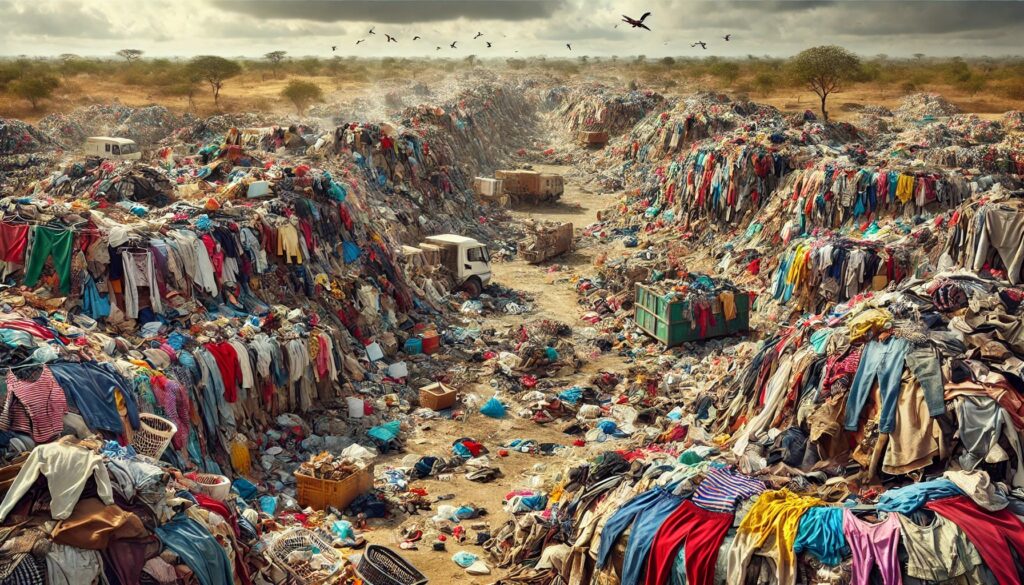
What is the fast fashion graveyard? It is a place where the fast fashion clothing waste ends up, causing environmental disasters.
What is fast fashion? Fast fashion is called fast fashion because it is produced extremely quickly and to give it the same connotations as fast food. Just like fast food, the clothes are made as quickly as possible, with the cheapest materials possible, the people who make them are not paid enough, and they are not good for anybody’s health. The number of clothes produced between 2000 and 2014 has more than doubled. This is down to fast fashion, although the growth of fast fashion is because the demand is there. Clothes used to be expensive and people would treat them with care, fixing them when necessary, and keep them for as long as possible. Replacing them was expensive. Once fast fashion appeared, the price of clothes dramatically dropped and people were able to buy far more clothes, discarding them when they wore out rather than trying to repair them. Once more people were buying the clothes, more manufacturers jumped onboard and the price continued to drop, feeding the demand. However, despite fast fashion only really taking off after 2000, the term “fast fashion” was coined in 1990 by the New York Times. The story was about a designer who had the goal of getting fashion from the designer’s brain to being sold on the racks in 15 days.
What are the problems with fast fashion? There are several. The first is the conditions that the people who make the clothes are forced to work in. They are paid a pittance and have to work in unsafe conditions. Often, many of the workers are children. An example of the unsafe conditions is the collapse of the Rana Plaza building collapse in Bangladesh in 2005. The building was 8 stories and when it collapsed, 1,134 people were killed and another 2,500 were rescued. 3,634 people working in a small, unsafe building. The second problem is that the majority of the clothes are made of textile fibers that are made of plastic, such as polyester. Fast fashion is one of the biggest sources of plastic waste. A third problem is the amount of water pollution produced by these mostly unregulated industries and the fourth problem is the increase in demand and the way we think about clothes now.
So, what are the fast fashion graveyards? There are several around the world, but two of the largest are in Ghana and Chile. They are places where enormous quantities of fast fashion clothing waste end up. Ghana is not only a destination for fast fashion. It also has the world’s largest e-waste landfill. A lot of developing countries get paid to deal with the waste of richer countries and Ghana takes in millions of tons every year. The problem is, that they don’t have the infrastructure to deal with it that richer countries might, and it ends up being buried in giant landfills. Both Chile and Ghana import used clothes from many countries around the world. These clothes come from charity boxes, secondhand shops, and a whole range of places. What can’t be resold in the original country is packaged up into giant bales and sold to Chile and Ghana. They import the bales of used clothes and people who work in their used closing industry can buy these bales. They can pay up to $200 for a bale and they have no idea what is inside it. Once they open the bale, they sort through to see what they can resell, what they can fix, and the rest they throw away. The majority of the clothes that come in this way are junk and are just thrown away. Because of this, the amount of clothes in landfill sites is increasing rapidly year by year.
The people who cannot afford to buy the bales have to fight for scraps and some of them trawl through the landfills to find anything they can resell. Some of the materials are recycled, but a lot are just burned. Fires can spontaneously break out on landfill sites, and they are very dangerous places. The chemicals also leach into local rivers. Most of the fast fashion that we throw away ends up in these places, which is something we need to think about. Another problem, though, is that the fast fashion industry has waste planned into it. They know that a huge amount of their clothes will be thrown away and they intentionally make more than they think they can sell just so that we can have all of the sizes and all of the colors that we need. We have become accustomed to buying clothes as cheaply as we can and then only wearing them for a few times before we throw them away. The clothes are taken to other countries where they are left to pollute the environment but, for us, it is out of sight and out of mind. And this is what I learned today.
Sources
https://www.nationalgeographic.com/environment/article/chile-fashion-pollution
https://www.bbc.com/news/av/world-60249712
